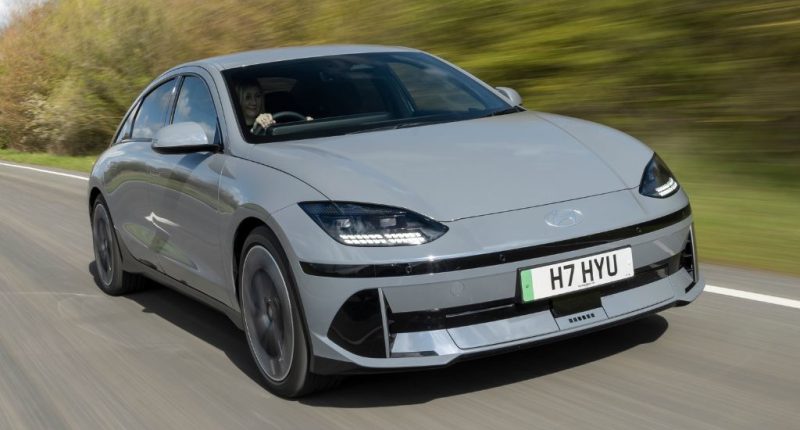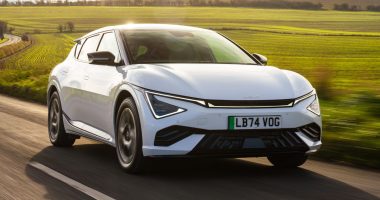Firstly, allow us to deal with the elephant in the room. You might not be able to tell from pictures of the Hyundai Ioniq 6 – officially called an ‘Electric Streamliner’ but in truth a sporty-looking car biased towards comfort rather than hard-edged dynamics – but this is an exceedingly large EV.
How big, we hear you ask? Well, nose to tail it measures 4,855mm (which makes it longer than its Ioniq 5 sibling, which is no shrinking violet) to accommodate the 77.4 kWh lithium-ion battery in the floor, and 1,880mm wide minus those sculpted wing mirrors for acres of leg and shoulder room.
There is no getting away from how this car looks, either. OK, it may be big – but it is also bold thanks to a roofline that is a shade under 1,500mm tall. This has allowed designers to craft a sleek and aerodynamic silhouette that cascades back to a rear section comprising a larger, grooved spoiler brake light and a more discreet lip that runs the entire length of the boot-lid. Other smart aspects of the final look include vanes at the outer edges of the front bumper that channel air down the smooth flanks.
The shape and those party tricks combine to deliver a drag coefficient of just 0.21Cd and therefore means in optimum conditions a real-world range of 338-miles; however, in the middle of a chilly November, 280-miles is the best you can hope for. Although this is a tad disappointing, the Ioniq 6 redeems itself in the economical way it uses up its battery’s reserves and how it tries to bank this through a choice of four regenerative braking levels to extend the period between recharges.
When the time does come to top up an 800-volt charging system allows the Ioniq 6 to accept 220kW and guarantees getting you from 10% to 80% in just 18 minutes. If, like us, you have to rely on a 50kW rapid charger, 60% to 100%, for instance, requires the best part of 60 minutes.
Buyers have two ways to deplete this energy: a rear-wheel-drive model as tested here (a single electric motor that produces 225bhp for impressive but not earth shattering acceleration given the sheer kerb weight), or an all-wheel-drive option that has a much healthier 321bhp to play with. Flicking between ‘Eco’, ‘Normal’ and ‘Sport’ will also dictate if energy consumption rises or falls and also how quickly the sprint from 0-62mph is ticked off.
As for how it drives, the Ioniq 6 is remarkably easy to manoeuvre despite its size; steering that can be turned with your little finger, parking sensors and an active rear-facing camera all help, of course. On the move, there is only a teeny amount of groan as you pull away from a parking space or road end before this fades away into the background.
Incredibly, despite riding on beautiful diamond cut 20-inch alloys that are wrapped in Pirelli P Zero rubber, these create virtually little or no chatter on the move. However, they do play their part in making for a busy ride; you won’t find it truly uncomfortable, although it does take the shine off a mostly enjoyable experience given how well the chassis is tied down.
Surrounded by mood lighting, textured plastics and metal accents, the cabin is a welcoming and spacious environment. It is also crammed with tech, including two 12.3-inch digital displays that side-by-side to create the impression that it is a single unit. Either way, we really like it – a lot.
As part of its marketing pitch, Hyundai claims the Ioniq 6 is “the perfect on the road office” and, for once, that is something we cannot argue with: it really is a modern-day office, albeit on wheels.
Sitting in the rear, with the heated seats at their highest setting, laptop plugged into the three-pin socket at the base of the rear bench, and smartphones being trickle fed energy via the two USB-C ports, it takes mobile working to a whole new level. Leg and foot room are limousine-like and the drop-down centre arm rest can double up as a makeshift mouse pad.
Downsides? There aren’t many, in truth, but the door bins on the front and rear doors are neither deep nor incredibly wide. Another compromise is the boot. 401-litres should be able to tackle most day-to-day needs, yet it is too shallow and not especially long. A redeeming feature for rear-wheel-drive cars is the extra 41-litre compartment beneath the bonnet that is suitably shaped for stowing away the charging cables.
And how much for a car that is a step on from the already brilliant Ioniq 5? It currently has a RRP range of £47,040 to £55,290.









